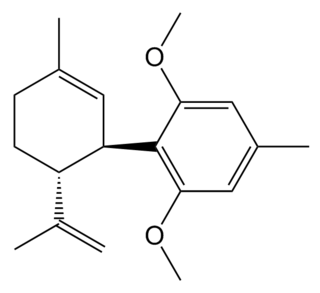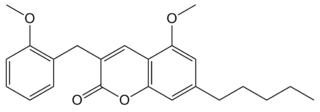
Cannabinoid receptors, located throughout the body, are part of the endocannabinoid system, which is involved in a variety of physiological processes including appetite, pain-sensation, mood, and memory.

CP 55,940 is a synthetic cannabinoid which mimics the effects of naturally occurring THC. CP 55,940 was created by Pfizer in 1974 but was never marketed. It is currently used to study the endocannabinoid system.

G protein-coupled estrogen receptor 1 (GPER), also known as G protein-coupled receptor 30 (GPR30), is a protein that in humans is encoded by the GPER gene. GPER binds to and is activated by the female sex hormone estradiol and is responsible for some of the rapid effects that estradiol has on cells.

The KiSS1-derived peptide receptor is a G protein-coupled receptor which binds the peptide hormone kisspeptin (metastin). Kisspeptin is encoded by the metastasis suppressor gene KISS1, which is expressed in a variety of endocrine and gonadal tissues. Activation of the kisspeptin receptor is linked to the phospholipase C and inositol trisphosphate second messenger cascades inside the cell.

The adenosine A2A receptor, also known as ADORA2A, is an adenosine receptor, and also denotes the human gene encoding it.

G protein-coupled receptor 35 also known as GPR35 is a G protein-coupled receptor which in humans is encoded by the GPR35 gene. Heightened expression of GPR35 is found in immune and gastrointestinal tissues, including the crypts of Lieberkühn.

Neuropeptides B/W receptor 1, also known as NPBW1 and GPR7, is a human protein encoded by the NPBWR1 gene. As implied by its name, it and related gene NPBW2 are transmembranes protein that bind Neuropeptide B (NPB) and Neuropeptide W (NPW), both proteins expressed strongly in parts of the brain that regulate stress and fear including the extended amygdala and stria terminalis. When originally discovered in 1995, these receptors had no known ligands and were called GPR7 and GPR8, but at least three groups in the early 2000s independently identified their endogenous ligands, triggering the name change in 2005.

N-Arachidonyl glycine receptor, also known as G protein-coupled receptor 18 (GPR18), is a protein that in humans is encoded by the GPR18 gene. Along with the other previously "orphan" receptors GPR55 and GPR119, GPR18 has been found to be a receptor for endogenous lipid neurotransmitters, several of which also bind to cannabinoid receptors. It has been found to be involved in the regulation of intraocular pressure.

Probable G-protein coupled receptor 26 is a protein that in humans is encoded by the GPR26 gene. GPR26 expression is found to peak perinatally, when the visual system is first challenged, and contains a 53 kb LD-block enriched for association with introgressed Neanderthal-derived SNPs. Additionally, it is known to form oligomeric structures with the 5-HT1a receptor.

G protein-coupled receptor 55 also known as GPR55 is a G protein-coupled receptor that in humans is encoded by the GPR55 gene.

G protein-coupled receptor 126 also known as VIGR and DREG is a protein encoded by the ADGRG6 gene. GPR126 is a member of the adhesion GPCR family. Adhesion GPCRs are characterized by an extended extracellular region often possessing N-terminal protein modules that is linked to a TM7 region via a domain known as the GPCR-Autoproteolysis INducing (GAIN) domain.

The 5-HT7 receptor is a member of the GPCR superfamily of cell surface receptors and is activated by the neurotransmitter serotonin (5-hydroxytryptamine, 5-HT) The 5-HT7 receptor is coupled to Gs (stimulates the production of the intracellular signaling molecule cAMP) and is expressed in a variety of human tissues, particularly in the brain, the gastrointestinal tract, and in various blood vessels. This receptor has been a drug development target for the treatment of several clinical disorders. The 5-HT7 receptor is encoded by the HTR7 gene, which in humans is transcribed into 3 different splice variants.

G-protein coupled receptor 3 is a protein that in humans is encoded by the GPR3 gene. The protein encoded by this gene is a member of the G protein-coupled receptor family of transmembrane receptors and is involved in signal transduction.

G protein-coupled receptor 50 is a protein which in humans is encoded by the GPR50 gene.

Abnormal cannabidiol (Abn-CBD) is a synthetic regioisomer of cannabidiol, which unlike most other cannabinoids produces vasodilator effects, lowers blood pressure, and induces cell migration, cell proliferation and mitogen-activated protein kinase activation in microglia, but without producing any psychoactive effects.

SR144528 is a drug that acts as a potent and highly selective CB2 receptor inverse agonist, with a Ki of 0.6 nM at CB2 and 400 nM at the related CB1 receptor. It is used in scientific research for investigating the function of the CB2 receptor, as well as for studying the effects of CB1 receptors in isolation, as few CB1 agonists that do not also show significant activity as CB2 agonists are available. It has also been found to be an inhibitor of sterol O-acyltransferase, an effect that appears to be independent from its action on CB2 receptors.

O-1918 is a synthetic compound related to cannabidiol, which is an antagonist at two former orphan receptors GPR18 and GPR55, that appear to be related to the cannabinoid receptors. O-1918 is used in the study of these receptors, which have been found to be targets for a number of endogenous and synthetic cannabinoid compounds, and are thought to be responsible for most of the non-CB1, non-CB2 mediated effects that have become evident in the course of cannabinoid research.
PSB-SB-487 is a coumarin derivative which is an antagonist at the former orphan receptor GPR55. Unlike older GPR55 antagonists such as O-1918, PSB-SB-487 has good selectivity over the related receptor GPR18, with an IC50 of 113nM at GPR55 vs 12500nM at GPR18. However it has poorer selectivity over other related receptors, acting as a weak antagonist at CB1 with a Ki of 1170nM, and a partial agonist at CB2 with a Ki of 292nM.

PSB-SB-1202 is a coumarin derivative which is an agonist at the cannabinoid receptors CB1 and CB2, with a CB1 Ki of 32nM and a CB2 Ki of 49nM. It is also a weak antagonist at the related receptor GPR55, with an IC50 of 6350nM, but has no significant affinity for GPR18.

CID16020046 is a compound which acts as an inverse agonist at the former orphan receptor GPR55, and may be the first selective inverse agonist characterised for this receptor. It was found to block a number of GPR55 mediated responses such as wound healing and activation of immune system T-cells and B-cells, as well as showing inverse agonist activity in the absence of GPR55 agonist stimulation. However while it was found to have good selectivity over the related CB1 and CB2 cannabinoid receptors as well as a number of other targets, CID16020046 has not yet been tested against another related receptor GPR18, so its selectivity for GPR55 over this target has not been established. It has antiinflammatory actions, has been used to study the interaction between GPR55 mediated and CB1 mediated activity, and research using this compound has revealed a role for GPR55 in learning and memory.

















